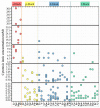Cationic Substitutions in Hydroxyapatite: Current Status of the Derived Biofunctional Effects and Their In Vitro Interrogation Methods
- PMID: 30355975
- PMCID: PMC6266948
- DOI: 10.3390/ma11112081
Cationic Substitutions in Hydroxyapatite: Current Status of the Derived Biofunctional Effects and Their In Vitro Interrogation Methods
Abstract
High-performance bioceramics are required for preventing failure and prolonging the life-time of bone grafting scaffolds and osseous implants. The proper identification and development of materials with extended functionalities addressing socio-economic needs and health problems constitute important and critical steps at the heart of clinical research. Recent findings in the realm of ion-substituted hydroxyapatite (HA) could pave the road towards significant developments in biomedicine, with an emphasis on a new generation of orthopaedic and dentistry applications, since such bioceramics are able to mimic the structural, compositional and mechanical properties of the bone mineral phase. In fact, the fascinating ability of the HA crystalline lattice to allow for the substitution of calcium ions with a plethora of cationic species has been widely explored in the recent period, with consequent modifications of its physical and chemical features, as well as its functional mechanical and in vitro and in vivo biological performance. A comprehensive inventory of the progresses achieved so far is both opportune and of paramount importance, in order to not only gather and summarize information, but to also allow fellow researchers to compare with ease and filter the best solutions for the cation substitution of HA-based materials and enable the development of multi-functional biomedical designs. The review surveys preparation and synthesis methods, pinpoints all the explored cation dopants, and discloses the full application range of substituted HA. Special attention is dedicated to the antimicrobial efficiency spectrum and cytotoxic trade-off concentration values for various cell lines, highlighting new prophylactic routes for the prevention of implant failure. Importantly, the current in vitro biological tests (widely employed to unveil the biological performance of HA-based materials), and their ability to mimic the in vivo biological interactions, are also critically assessed. Future perspectives are discussed, and a series of recommendations are underlined.
Keywords: biological assays; biomedicine; cation substitution; co-doping; hydroxyapatite.
Conflict of interest statement
The authors declare no conflict of interest.
Figures




References
-
- Antoniac I.V. Handbook of Bioceramics and Biocomposites. Springer; Berlin, Germany: 2016.
-
- Mucalo M. Hydroxyapatite (HAp) for Biomedical Applications. Elsevier; Amsterdam, The Netherlands: 2015.
-
- Šupová M. Substituted hydroxyapatites for biomedical applications: A review. Ceram. Int. 2015;41:9203–9231. doi: 10.1016/j.ceramint.2015.03.316. - DOI
Publication types
Grants and funding
LinkOut - more resources
Full Text Sources
Molecular Biology Databases

